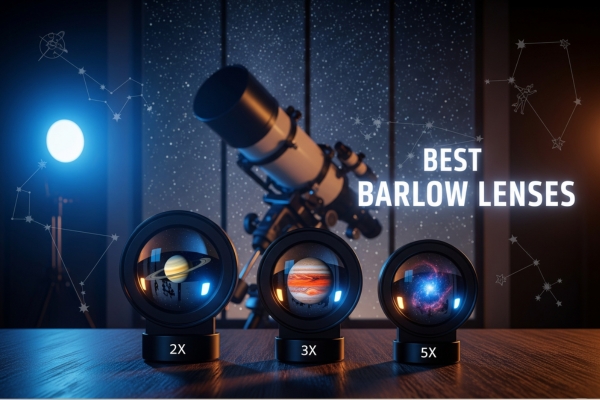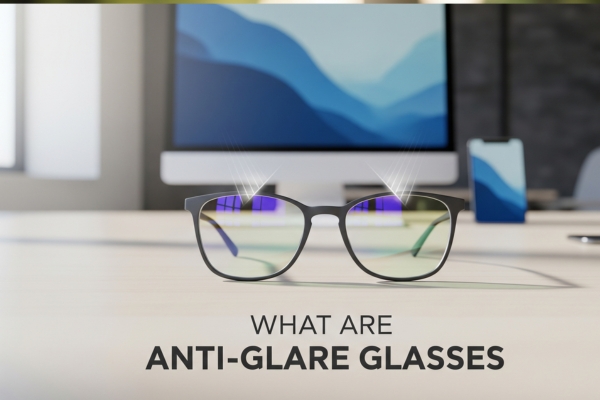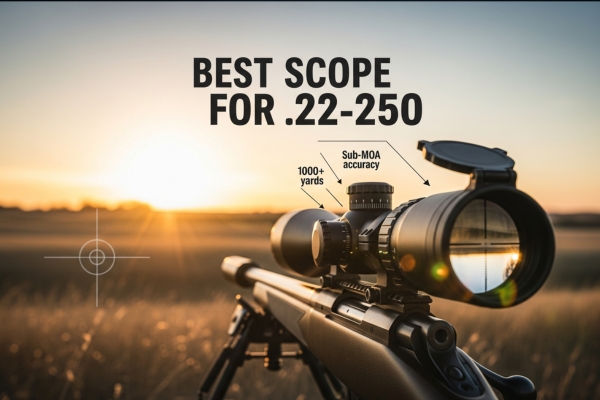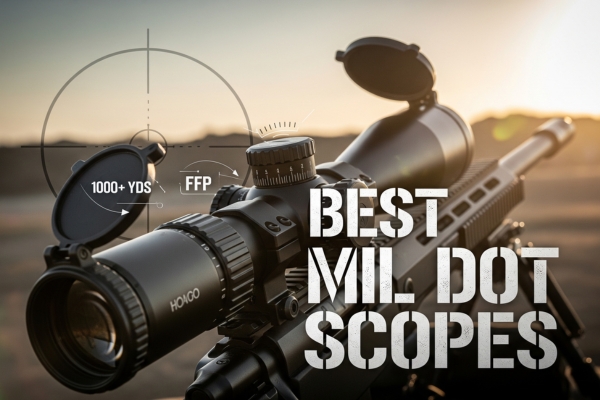

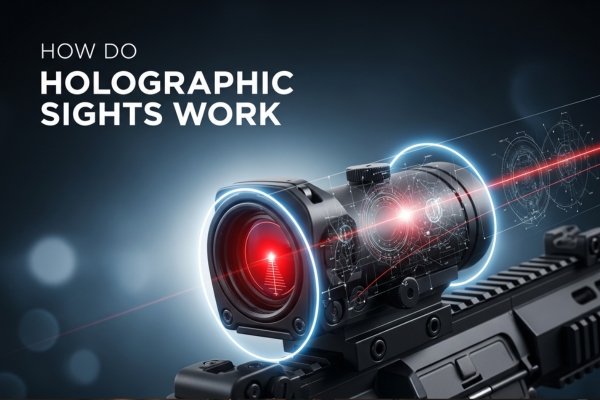

When I first looked through a holographic sight at a shooting range, the floating red reticle seemed like pure magic. Unlike traditional scopes where you need perfect eye alignment, this crisp hologram appeared to hover in space, staying on target no matter how I moved my head. After spending years working with various optical systems, I’ve come to appreciate the fascinating physics that makes holographic sights possible.
Holographic weapon sights represent one of the most significant advances in aiming technology since the invention of telescopic sights. These sophisticated devices use laser-generated holograms to project a reticle that appears to float at the target distance, providing shooters with unprecedented speed and accuracy. Whether you’re a competitive shooter, law enforcement professional, or simply curious about optical technology, understanding how these systems work reveals why they’ve become the gold standard for rapid target acquisition.
In this comprehensive guide, we’ll explore the physics behind holographic sights, examine their unique advantages over other sighting systems, and understand why military and law enforcement agencies worldwide have adopted this technology. I’ll break down the complex science into digestible concepts while maintaining technical accuracy for those who want the complete picture.
At its core, a holographic sight creates a three-dimensional image using the principles of wave interference and diffraction. This technology, invented by Dennis Gabor in 1948 (who later won the Nobel Prize in Physics in 1971), didn’t become practical for weapon sights until the development of reliable laser diodes in the 1990s.
Traditional optics work by bending light through lenses to magnify or focus an image. Holographic sights take a completely different approach. They record and reconstruct light waves to create a three-dimensional image that appears to exist in space. Think of it like the difference between looking at a photograph and looking through a window – one is flat and two-dimensional, while the other preserves depth and perspective.
The process starts with a laser diode, typically producing red light at 650 nanometers wavelength. This laser light has a special property called coherence, meaning all the light waves are synchronized and travel in the same direction. Without this coherence, creating a stable hologram would be impossible.
When this coherent laser light strikes the holographic grating (a specially designed optical element with microscopic patterns), it diffracts into a specific pattern. This diffraction pattern reconstructs the recorded image of the reticle, making it appear as if it’s floating at a specific distance – typically 50 to 100 yards for most holographic sights.
Creating the holographic grating that forms the heart of these sights requires extreme precision. Manufacturers use a process called holographic recording, where two laser beams interfere with each other to create an interference pattern. One beam (the reference beam) travels directly to the recording medium, while the other (the object beam) bounces off the desired reticle pattern.
Where these two beams meet, they create bright and dark fringes based on constructive and destructive interference. These interference patterns are recorded in a photosensitive material, creating a permanent holographic grating. When illuminated by the sight’s laser diode during use, this grating reconstructs the original reticle pattern.
The recording process must occur in a vibration-free environment, as movements smaller than the wavelength of light (about 650 billionths of a meter) can ruin the hologram. This explains why holographic sights are expensive – the manufacturing process requires specialized equipment and clean room conditions.
Understanding the individual components helps explain how these complex devices achieve their remarkable performance. Each element plays a crucial role in creating the final sight picture.
The laser diode serves as the light source for the entire system. Modern holographic sights use solid-state laser diodes that produce highly coherent light while consuming minimal power. These diodes are temperature-stabilized to maintain consistent wavelength output across a wide range of operating conditions, typically from -40°F to 140°F.
The laser output is carefully controlled to provide enough brightness for daylight visibility without overwhelming the shooter’s vision in low-light conditions. Most holographic sights offer multiple brightness settings, with some models featuring automatic brightness adjustment based on ambient light levels.
The holographic optical elements are the true heart of the system. These consist of multiple layers of specialized materials that work together to create and project the reticle image. The primary HOE is the holographic grating we discussed earlier, which contains the recorded interference pattern of the reticle.
A second crucial element is the image relay system, which ensures the hologram appears at the correct distance and orientation. This typically involves a combination of mirrors and lenses that fold the optical path, allowing the sight to maintain a compact form factor while projecting the image at the desired distance.
The front and rear windows of a holographic sight do more than just protect the internal components. These windows are coated with anti-reflective materials to minimize light loss and prevent the enemy from detecting reflections in tactical situations. Some models also incorporate filters that enhance contrast in specific lighting conditions.
The windows must be optically flat to avoid distorting the sight picture. Even minor imperfections can affect accuracy, so manufacturers use precision-ground glass with flatness tolerances measured in fractions of a wavelength of light.
While holographic and red dot sights might appear similar to casual observers, they operate on fundamentally different principles. Understanding these differences helps explain why each technology excels in different applications.
Red dot sights use a simple LED (light-emitting diode) that projects light onto a specially coated lens. This lens, called a beam splitter, reflects the red light back to your eye while allowing light from the target to pass through. The result is a red dot superimposed on your target view.
Holographic sights, as we’ve discussed, use laser light and holographic gratings to create a three-dimensional image. This fundamental difference in technology leads to several practical advantages and disadvantages for each system.
One of the most significant advantages of holographic sights is their superior parallax performance. Parallax is the apparent movement of the reticle relative to the target when you move your head position. In a perfect sight with zero parallax, the reticle stays on the same point of impact regardless of where your eye is positioned behind the sight.
Holographic sights are essentially parallax-free within their viewing window. Because the hologram reconstructs light waves as if they’re coming from the target distance, the reticle truly appears to be at the target plane. This means you can shoot accurately even with poor cheek weld or from awkward positions.
Red dot sights can be parallax-free at a specific distance (usually 50 or 100 yards), but parallax error increases as you move closer or farther from this distance. High-quality red dots minimize this effect, but they can’t match the inherent parallax-free nature of holographic technology.
Here’s where holographic sights truly shine: they can function even with significant window damage. If the front window of a holographic sight gets cracked or partially destroyed, the sight continues to work as long as you can see through any portion of the remaining hologram. The entire reticle pattern is recorded throughout the holographic grating, so any intact portion can reconstruct the complete image.
Red dot sights fail completely if the LED or beam splitter coating is damaged. A crack through the coating creates a break in the reflected dot, potentially rendering the sight useless. This durability difference makes holographic sights particularly valuable in military and law enforcement applications where equipment damage is a real concern.
The advanced technology of holographic sights comes with a significant drawback: battery consumption. A typical holographic sight runs for 600-1,000 hours on a single battery, while modern red dot sights can operate for 10,000-50,000 hours. Some red dots with motion sensors can last up to 5 years on a single battery.
This difference stems from the power requirements of laser diodes versus simple LEDs. Laser diodes need more current to maintain coherent light output, and the supporting electronics for temperature stabilization and brightness control add to the power draw. For civilian shooters who might forget to turn off their sight, this can be a significant consideration.
Despite the battery life limitation, holographic sights offer several compelling advantages that make them the preferred choice for many professional applications.
Eye relief refers to the distance your eye can be from the sight while still seeing the full sight picture. Holographic sights offer unlimited eye relief – you can hold the sight at arm’s length and still see and use the reticle effectively. This flexibility proves invaluable when shooting from unconventional positions or when wearing gas masks or night vision goggles.
This unlimited eye relief also speeds up target acquisition. You don’t need to find the perfect head position; as soon as you see the window, you see the reticle. In dynamic shooting situations where fractions of a second matter, this advantage can be decisive.
The laser-generated hologram in these sights produces an incredibly crisp, clear reticle that maintains its sharpness in all lighting conditions. Unlike red dots, which can appear fuzzy or develop a “starburst” effect for shooters with astigmatism, holographic reticles remain sharp and well-defined.
In low-light conditions, you can dial down the brightness to avoid washing out your night vision while maintaining a perfectly visible reticle. The holographic image doesn’t bloom or flare like LED-based systems, preserving your ability to see the target clearly.
Holographic technology allows for complex reticle designs that would be impossible with simple LED projection. Many holographic sights feature circle-dot reticles with multiple aiming points for different distances. Some military models include ballistic drop compensators and windage references built into the reticle pattern.
These complex reticles are recorded into the hologram during manufacturing, so they don’t require additional power or components. The entire pattern appears simultaneously, giving shooters multiple reference points without cluttering the sight picture.
Military and law enforcement units particularly value holographic sights for their compatibility with night vision devices. These sights can operate at brightness levels invisible to the naked eye but perfectly visible through night vision goggles. The narrow wavelength output of the laser diode also means less blooming through night vision compared to the broader spectrum output of LEDs.
Many holographic sights include specific night vision settings that optimize the reticle brightness for use with Generation 3 and 4 night vision devices. This seamless integration makes them ideal for operations that transition between daylight and darkness.
While holographic sights offer impressive capabilities, they also come with several limitations that users should understand.
Holographic sights typically cost 3-5 times more than comparable quality red dot sights. Entry-level holographic sights start around $450-$600, while professional-grade models run $800-$1,200. This high cost stems from the complex manufacturing process, specialized components, and limited number of manufacturers.
Currently, EOTech dominates the holographic sight market, with Vortex’s Razor AMG UH-1 being one of the few alternatives. This limited competition keeps prices high and reduces options for consumers. The patent protection and technical barriers to entry mean this situation isn’t likely to change soon.
Holographic sights are generally larger and heavier than red dot sights. The laser diode, holographic elements, and supporting electronics require more space than a simple LED and lens system. A typical holographic sight weighs 8-11 ounces, while compact red dots can weigh as little as 1-3 ounces.
This additional bulk can affect weapon balance and handling, particularly on lightweight rifles or pistols. For users who prioritize a minimalist setup, the size penalty of holographic sights might outweigh their technical advantages.
While modern holographic sights are designed to operate across a wide temperature range, extreme temperatures can affect zero retention. The thermal expansion and contraction of the holographic elements can cause slight shifts in point of impact, particularly when moving between temperature extremes.
EOTech faced controversy in 2015 when it was revealed that some models experienced more thermal drift than advertised. While current models have addressed these issues, users operating in extreme environments should verify zero after significant temperature changes.
The sophisticated electronics in holographic sights require more careful handling than simple red dots. Moisture intrusion can damage the laser diode or fog the internal optics, though military-grade models are well-sealed against environmental hazards. The battery compartments need regular inspection to ensure the seals remain intact.
Understanding where holographic sights excel helps explain their continued popularity despite their limitations.
Military units worldwide have adopted holographic sights for close-quarters combat and urban operations. The U.S. military has fielded hundreds of thousands of EOTech sights in Iraq and Afghanistan, where their durability and performance in harsh conditions proved invaluable.
Special operations forces particularly appreciate the night vision compatibility and ability to engage targets quickly from unconventional shooting positions. The parallax-free operation allows accurate shooting through barriers or from vehicles where perfect shooting form isn’t possible.
Law enforcement tactical teams use holographic sights for similar reasons. In hostage rescue or active shooter situations, officers need equipment that works reliably under stress. The intuitive sight picture and unlimited eye relief of holographic sights reduce training time while improving first-shot accuracy.
Competitive shooters in sports like 3-gun and USPSA have embraced holographic sights for their speed advantages. The large viewing window and parallax-free operation allow shooters to track the reticle through recoil and quickly transition between targets.
The 65 MOA circle in many holographic reticles serves as a quick reference for close targets – simply place the circle on a close target and fire without needing to find the center dot. This technique, called “occluding,” can shave precious seconds off stage times.
While less common in hunting than red dots, holographic sights excel in specific hunting scenarios. Dangerous game hunters appreciate the quick target acquisition and ability to keep both eyes open while tracking moving animals. The wide field of view helps maintain situational awareness in environments where threats can appear suddenly.
Turkey hunters have found holographic sights particularly effective. The precise aiming point helps ensure clean kills at the relatively close ranges typical of turkey hunting, while the circle reticle can help judge distance and shot spread.
The technology behind holographic sights continues to evolve, with several exciting developments on the horizon.
Next-generation holographic sights are beginning to incorporate smart features like ballistic calculators, range finders, and environmental sensors. These systems can automatically adjust the reticle for distance, wind, and atmospheric conditions, taking much of the guesswork out of long-range shooting.
Some experimental systems include video recording capabilities and wireless connectivity for sharing sight pictures with team members or command centers. While these features add complexity and cost, they represent the future of integrated weapon systems.
Manufacturers are working to address the battery life disadvantage of holographic sights. New laser diode designs promise better efficiency, while advanced power management systems can automatically adjust brightness and enter sleep modes to extend battery life.
Some companies are experimenting with alternative power sources, including solar panels and kinetic energy harvesting from recoil. While these technologies aren’t ready for production, they could eventually eliminate battery concerns entirely.</n
Materials science advances are leading to more robust holographic elements that better resist temperature changes and physical shock. New coating technologies improve scratch resistance and reduce the visibility signature of the sight, important considerations for military users.
Research into polymer holographic elements could reduce weight and cost while maintaining optical performance. These materials might also allow for flexible or conformal sights that integrate more seamlessly with weapon systems.
Choosing between a holographic sight and other options depends on your specific needs and priorities. Let me break down the key decision factors.
Choose a holographic sight if you need maximum performance in dynamic shooting situations. Professional users who can justify the cost and maintain their equipment properly will appreciate the technical advantages. If you frequently shoot from unconventional positions, use night vision, or need absolute reliability when equipment damage is possible, holographic sights offer unmatched capability.
Competitive shooters who prioritize speed over battery life will find holographic sights give them an edge. The combination of unlimited eye relief, parallax-free operation, and intuitive sight picture can translate directly into better scores and faster times.
For most civilian shooters, a quality red dot sight offers better value. If you primarily shoot at a fixed distance from stable positions, the parallax advantage of holographic sights becomes less important. Hunters who leave their sights on continuously will appreciate the extended battery life of red dots.
Budget-conscious shooters should remember that a $200-$300 red dot from a reputable manufacturer will serve most needs admirably. The money saved could go toward training ammunition or other gear that might provide more practical benefit than the incremental advantages of holographic technology.
Traditional scopes remain superior for precision long-range shooting where magnification is essential. While holographic sights can be paired with magnifiers, this combination is bulkier and more expensive than a quality low-power variable optic.
No, holographic sights require battery power to operate the laser diode. Without power, you have no reticle at all. This differs from etched reticle scopes or iron sights that work without any power source. Always carry spare batteries and consider backup iron sights for critical applications.
Yes, most people with astigmatism find holographic sights provide a clearer sight picture than red dots. The laser-generated hologram produces a sharper image that doesn’t distort as much for users with irregular corneas. However, individual experiences vary, so try before buying if possible.
The manufacturing process for holographic sights requires specialized equipment, clean room facilities, and extreme precision. Creating the holographic gratings involves recording interference patterns at the wavelength of light – tolerances measured in billionths of a meter. Limited competition and patent protection also contribute to high prices.
Replace batteries every 6-12 months regardless of use, or immediately when you notice dimming. For duty weapons, many professionals change batteries on a set schedule (like every January 1st) to avoid failures. Always verify zero after battery changes, as the sight may shift slightly.
Quality holographic sights are water-resistant or waterproof, with military models tested to significant depths. However, they’re not designed for underwater use. After exposure to water, inspect battery compartment seals and dry the sight thoroughly to prevent corrosion.
Holographic sights are typically zeroed at 50-200 yards and remain effective to 300-400 yards on rifle-caliber weapons. The limiting factor isn’t the sight but the lack of magnification – targets become too small to precisely engage with a 1x optic beyond these distances.
Yes, holographic sights work excellently with flip-to-side magnifiers, typically 3x to 5x. The holographic reticle remains sharp when magnified, unlike some red dots that can appear pixelated. This combination provides versatility for both close and medium-range engagements.
Zeroing a holographic sight follows the same process as other optics. Start at 25 yards to get on paper, then fine-tune at your desired zero distance (typically 50 or 100 yards). Most holographic sights adjust in 0.5 MOA increments. Always confirm zero after installation, battery changes, or significant impacts.
Holographic sights represent a remarkable fusion of physics and engineering, using Nobel Prize-winning technology to solve practical shooting challenges. By reconstructing light waves to create a true three-dimensional image, these sights provide capabilities that no other technology can match.
The principles behind holographic sights – wave interference, diffraction, and coherent light – might seem complex, but the result is elegantly simple: a floating reticle that stays on target regardless of your eye position. This parallax-free performance, combined with exceptional durability and low-light capability, explains why military and law enforcement agencies trust these sights in life-or-death situations.
While the high cost and limited battery life of holographic sights mean they’re not ideal for everyone, understanding their technology helps appreciate why they command premium prices. For users who need maximum performance and can manage the limitations, holographic sights offer unmatched capability.
As technology advances, we’ll likely see improvements in power efficiency and new features that further distinguish holographic sights from simpler alternatives. However, the fundamental physics that makes these sights special – the ability to reconstruct light waves and create true holograms – will remain at the heart of this remarkable technology.
Whether you’re a professional operator, competitive shooter, or simply someone interested in optical technology, holographic sights demonstrate how advanced physics can solve real-world problems. The next time you see that floating red reticle, you’ll understand the incredible science making it possible.


